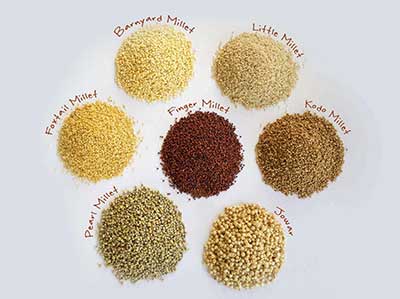Date: 02/02/2023
Relevance: GS-2: Health, Nutrition and related topics.
Relevance: GS-3: Major Crops - Cropping Patterns in various parts of the country; Transport and Marketing of Agricultural Produce and Issues and Related Constraints.
Key Phrases: Food and Agriculture Organization (FAO), Millet, Nutritional Cereals, Drought-Resistant, Semi-arid areas, Export, Food Processing Industry, Value-added products, Super Food, Protein, Dietary fiber, Micronutrients and Antioxidants, MSP, PDS.
Context:
- The Food and Agriculture Organization of the United Nations (FAO) has declared 2023 as the International Year of Millets.
Key Highlights:
- Two groups of millets are grown in India.
- Major millets include sorghum (Jowar), pearl millet (Bajra) and finger millet (Ragi), while minor millets include foxtail, little millet, kodo, proso, and barnyard millet.
- As the Indian Council of Agricultural Research (ICAR) has pointed out, the area under nutri-cereals has declined steeply in India since the mid-1980s — from 41 million hectares in the 1980s to 24 million hectares in 2017-18.
- Earlier, India had observed 2018 as the National Year of Millets to boost the production of the nutrient-rich cereal.
- Millets are now grown in more than 130 countries, and are the traditional food for more than half a billion people in Asia and Africa.
- The government declares a Minimum Support Price (MSP) for jowar, bajra, and ragi only.
Significance of Millets:
- Nutritional Benefits
- Millets have special nutritive properties since they are high in protein, dietary fiber, micronutrients and antioxidants.
- Because they are fiber-rich grains, they are a great probiotic
for micro-flora in our gut.
- The fiber in millets hydrates our colon and helps prevent constipation.
- Generally, they contain 7-12 percent protein, 2-5 percent fat, 65-75 per cent carbohydrates and 10-12 per cent fiber.
- Climatic Advantages
- Millets are warm weather grains, grown and consumed in the Indian subcontinent for more than 5,000 years.
- Belonging to the grass family, they are resilient, with low requirements of water and are thus highly tolerant to drought and other extreme weather conditions.
- They do not require fertilizers.
- They can develop from seeds to ready-to-harvest crops in about three months.
Constraints with Millets:
- Low Procurement and Consumption
- In 2019-20, the total offtake of cereals through the Public Distribution System (PDS) and the Integrated Child Development Scheme (ICDS) and also school meals was around 54 million tonnes.
- If about 20% of rice and wheat were to be replaced by millet, the state would have to procure 10.8 million tonnes of millet.
- In 2019-20, the total production of nutri-cereals was 47.7
million tonnes.
- The bulk of this was maize (28.8 million tonnes), a non-millet crop used mainly as feed.
- The production of sorghum (4.8 million tonnes), pearl millet (10.4 million tonnes), and finger millet along with other millets (3.7 million tonnes) put together was 18.9 million tonnes.
- With this production, the inclusion of millets in the PDS would only be feasible if more than 50% production were procured — an unlikely scenario.
- Currently, millets are procured in only a few States, and stocks in
the central pool are small.
- In May 2022, central stocks had 33 million tonnes of rice and 31 million tonnes of wheat, but only four lakh tonnes of nutri cereals.
- Low Production and Productivity
- The decline in the area under millet cultivation and low productivity of millets is the critical issue for the millets.
- Over the last decade, the production of sorghum (jowar) has fallen,the production of pearl millet (bajra) has stagnated,and the production of other millets, including finger millet (ragi), has stagnated or declined.
- The productivity of jowar and bajra has increased, but only
marginally.
- The average yield of jowar was 957 kg per hectare in 2011-12 and 989 kg per hectare in 2019-20.
- The yield of bajra was 1,079 kg per ha in 2010-11 and 1,237 kg per ha in 2017-18.
- Unless productivity and production are increased substantially, all exhortations to consume millets will come to naught.
Way Forward:
- Increasing the production of millets and reversing the decline in area cultivated are feasible steps but not easy, and require multiple interventions including scientific inputs, institutional mechanisms, financial incentives and in-kind support.
- The Government of India and State governments, notably Karnataka and
Odisha, have initiated Millet Missions.
- These policies are welcome, but unless we pay attention to the economics of millet cultivation, we face a losing battle against more profitable alternatives.
- Small farmers in hilly regions and dryland plains who are among
the poorest households in rural India, are going to cultivate millets only
if it gives them good returns.
- Adequate public support can make millet cultivation profitable, ensure supply for the PDS, and, ultimately, provide nutritional benefits to a wide section of the population.
Conclusion:
- Millet is the superfood of the future and India has a diverse variety of
millets that are easily grown and available, at a very affordable price.
- Therefore, We need to embrace it more and include it in our diets.
Source: The Hindu
Mains Question:
Q. What are the benefits of millets? Also discuss the associated issues of production, procurement and consumption in India.(250 Words)







